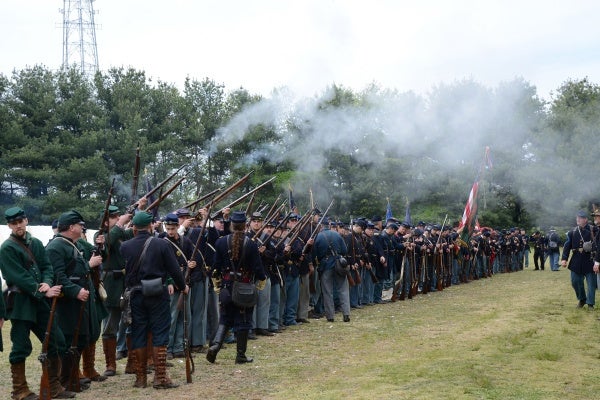Delaware’s Civil War split

(Max Matza/for NewsWorks)
A look back at the First State’s role in the Civil War as the landmark Ken Burns documentary series returns to the airwaves.
Delaware mirrored the nation during the Civil War. The state was somewhat divided in its loyalties with the northern part of the state closely connected with the Union and the southern portion more aligned with the Confederacy. Northern Delaware was home to industrial giants like DuPont, while southern Delaware’s economy was dominated by agriculture.
There are strong symbols representing Delaware’s divided status during the Civil War. As the last stop on the Underground Railroad, Wilmington was the gateway to freedom for slaves trying to escape. “Delaware is one of four slave states to have remained in the Union,” said University of Delaware history professor Jonathan Russ. Even though Delaware kept slavery legal, its history as an escape route for slaves is is remembered in the city at sites like Tubman-Garrett Park, named in honor of Harriet Tubman and Wilmington’s Underground Railroad stationmaster Thomas Garrett.
Further south, the Confederate side is remembered. Just outside of Georgetown in Sussex County there’s a monument dedicated to those willing to fight for the south. The monument has been there since 2007. “When the war began they were actually forming militias in the southern part of the state to serve the south,” said Jeff Plumer of the Confederate Grays Camp 468. “Everyone likes to say Delaware is a Yankee state, and northern state,” Plumer said. “Delaware was one of the 15 southern states.”
There were more than 2,000 Delawareans who had a connection to the Confederacy. “They were motivated by being self-governed. In other words they probably believed in states’ rights,” Plumer said.
“Delaware [was] a slave state,” said Willis Phelps, who portrays African American soldiers during the Civil War at Fort Delaware. “They called it a border state which is a nice name for a slave state.” The fort is another enduring symbol of the war in the First State. Originally built to defend Wilmington and Philadelphia, it became a prison camp to hold southern soldiers captured by the Union. “Ft. Delaware is unique in civil war prison in that we held not only officers, but regular enlisted men, ordinary civilians and federal convicts,” said Ft. Delaware’s Laura Lee.
Fort Delaware is open to visitors and gives a glimpse of what life was like there in the 1860’s. It’s population was over 11,000 after the Battle of Gettysburg. “You can imagine ships pulling up thousands of prisoners per day with it overwhelming the staff here.”
Thousands of those prisoners died. “Prison conditions were extraordinarily difficult,” Lee said. Those deaths were “due to disease and due to unsanitary living conditions.”
There was no place to bury them on the island that held the fort, so the bodies were moved just across the Delaware River from the fort to New Jersey. Now, the Confederate dead have their own section of a federal veterans cemetery at Finn Point located at Fort Mott State Park in New Jersey.
Nineteen of the Confederate prisoners captured at Gettysburg and taken to Fort Delaware were African American. Willis Phelps portrays those soldiers as a historical reenactor. “Our goal is to show the diversity of the war,” Phelps said. “They were skilled men, highly skilled men who made useful things.”
Phelps is also working to tell the story of Polktown, an area next to Delaware City near where Fort Delaware is located. It was home to free blacks during the Civil War era. “A place like Polktown was a sanctuary,” Phelps said. He’s working with University of Delaware researchers to explore a Polktown cemetery to learn more about who lived there.
—-
On Monday, the Ken Burns Civil War documentary series will air on WHYY TV from 9 to 11 p.m. The rest will air from Tuesday, September 8 through Friday, September 11 from 9 to 11:30 p.m.
WHYY is your source for fact-based, in-depth journalism and information. As a nonprofit organization, we rely on financial support from readers like you. Please give today.





